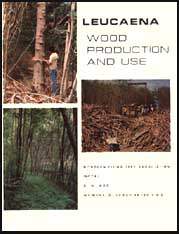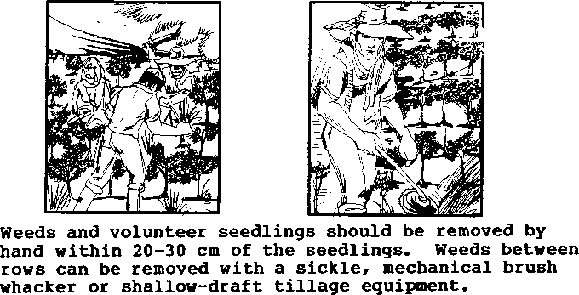Weeds are a major cause of failure and irregular field establishment of leucaena. Weed control is essential for reliable results. Regular hand weeding or cultivation between rows combined with hand hoeing within rows until plants are 1-2 m tall will give best results (Figure 6-1). On large plantations, or in areas where labor is expensive, the use of herbicides may be an attractive option.
Leucaena seedlings are susceptible to damage from a number of herbicides, notably to glyphosate. Post-plant sprays are best directed to the base of the seedlings rather than as a cover spray, to reduce damage. Both MSMA (2-5 a.i./ha) and paraquat (1 kg a.i./ha) can be used in this way, using shields to reduce drift onto the leucaena. Dalapon has been shown to be extremely promising when used as a touch-up herbicide on grassy weeds.
Weeds can also be controlled by careful application of glyphosate through wick applications.
Figure 6-1 Weed control in closely spaced Leucaena
6-2 INSECTS
The most serious insect pests of leucaena have been by ants on young seedlings, and seed weevils on seed pods. Mound-building ants have caused severe damage in some regions by eating seedling leaves and girdling young seedlings. Scale insects have caused mortality in Taiwan. Minute leafhoppers have affected height growth in Hawaii and the Caribbean during the dry season but have not been known to cause mortality in otherwise healthy trees. Suitable systemic insecticides may be employed if such sucking insects are noted.
Seed production can be reduced greatly and seed quality lowered by seed weevils, which may lead to disease infections as well. Chemical control is feasible (see Section 3-4). An occasional problem on seedlings and young shoots is caused by mites, but it is normally kept under control by predatory insects. Few chewing insects attack leucaena, although a defoliating looper and a twig borer have been reported.
6-3 DISEASES
Leucaena has been widely spread around the world for more than a century with surprisingly few reported disease problems. Reported diseases include a bark gummosis, one defoliation leafspot, and some fungal diseases of seedlings in nurseries.
Gummosis has been identified in several countries as a disease invading the plant at the soil surface, growing up the trunk and forming bleeding cankers. Although it is not known if the symptoms are caused by disease or harsh environmental conditions, fungal species including Fusarium semitectam and Phythophthora dreschsleri have been associated with it. Some leucaena varieties are unusually susceptible (i.e., K132), but most lines show less than 10% mortality. Wood quality can be severely affected by the cankers which begin to heal about 6 months after infection. Environmental stresses such as wind, drought, sunscald, or damage during weeding and harvesting increase disease incidence. Roguing of diseased plants is advisable, but generally no treatment is indicated.
Sunscald can occur in widely-spaced plantations or along breaks in the crown canopy caused by trails, rest houses and the like. Symptoms of sunscald closely mimic the gummosis disease, but are restricted to the side of the trunk facing the sun. Mortality from sunscald is rare.
Fungal diseases occur in nurseries, the most serious being damping-off caused by Pythium or Rhizoctonia spp. Sanitary procedures can reduce disease, and control with fungicides like Benlate and Captan is effective.
A defoliation disease of Central and South America that can be serious on wet sites is the leafspot fungus, Camptomeris leucaenae. Although the disease rarely causes death, it can affect wood increments in bad years. No control measures are reported. Several bacterial and fungal seed diseases have been recorded, normally as secondary invasions after pod damage from seed weevils. Systemic insecticides that control the weevil should prevent these diseases.
6-4 ANIMALS
The tender, nutritious foliage of leucaena is relished not only by livestock but also by many wild animals. In addition to cattle, sheep and goats, wild animals such as deer, elephants, wild pigs, kangaroos, rabbits and monkeys may also attack leucaena plants. Protection of the plantation may be necessary during early stages of establishment.
Few economic and practical methods exist for isolating plantations from such animals. Permanent fencing or individual tree barriers are expensive and hedges of thorny species require too much time in advance. Planting in small blocks and provision of constant field maintenance is advised. Ditches serve as useful barriers to cattle. A new approach in more capitalized ventures is to use portable, battery-powered electronic fences made of sigle flexible wires that can be powered up to 20 km from solar-powered batteries.
6-5 FIRE AND STORM
Leucaena has rather thin bark and is very susceptible to fire when young. Damage is more severe if grassy weeds are present in the stand or in surrounding areas. Wind-blown grass fires can do the greatest damage, although leucaena in full leaf is fairly slow to burn. Slow-moving, low intensity fires do less damage, burning out a short distance into leucaena stands. There is little likelihood of fire burning very far into a plantation since most undergrowth is eliminated by the leucaena, thus limiting the amount of fuel for a ground fire. Burned trees normally resprout from the base. Care should be taken to keep animals out of burned plantations to allow swift coppice regrowth.
Probably the best fire control measure is to plant leucaena with good fertilization and management, in order to hasten crown closure and suppress understory vegetation before the dry season. Plantation boundaries can be located below ridge lines or extended to bottoms of slopes to minimize fire damage.
Wind damage is generally restricted to minor branch breaking and defoliation, unless trees are rooted into waterlogged soils or are directly exposed to extreme winds (e.g. 150 kph). Typhoon damage is generally less than with other tree species, and regrowth is rapid from damaged trees. In typhoon-prone regions, plantings should be avoided on soils with shallow water tables, clay pans, or highly acid subsoil.
6-6 MAINTENANCE FERTILIZATION
The need for maintenance fertilization is best assessed on the basis of symptoms in the field. Slow growth and low yields often indicate a need for more phosphate, best supplied as single superphosphate banded or placed next to each tree at the rate of 100 kg/ha. In more acid soils, Ca deficiency in the subsoil can occur. Application of 100 kg/ha of calcium sulfate along the rows would alleviate this problem.
A general leaf yellowing can be due to sulfur deficiency, and the use of calcium sulfate can overcome this. Yellow leaf mottling may indicate zinc deficiency, easily corrected by application of zinc sulfate. Death of leaflet margins can indicate potassium deficiency.
The only reliable basis for maintenance fertilization is foliar analysis. Leaf samples need to be taken at the height of the growing season from newly matured leaves. For good growth, leaves should contain approximately 3.5% N. 0.15% P. 1.5% K, 1.0% Ca, 0.2% Mg, 7 ppm Cu. and 35 ppm Zn on a dry matter basis. If foliar analysis shows levels much lower than this, requisite amounts of appropriate fertilizers need to be applied.
Any large-scale leucaena operation which does not monitor fertilizer needs with foliar analysis is liable to make some costly mistakes.
6-7 IRRIGATION
Leucaena is a hardy, drought-tolerant plant which does not usually require irrigation after the initial establishment period, but the species does respond well to irrigation. Under severe drought conditions, growth is slowed by a reduction in height and diameter growth and dropping of leaves. A well distributed rainfall of approximately 1500 mm seems important for maximum yields. Supplemental irrigation, when feasible, may be especially important in seedling establishment, and can mean the difference between success and failure during unexpected dry periods.

